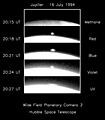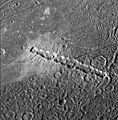Comet Shoemaker–Levy 9 facts for kids
Comet Shoemaker-Levy 9 was a special comet. It broke into many pieces and then crashed into the giant planet Jupiter in July 1994. This event was very important because it was the first time people could watch, from Earth, how objects in our Solar System collided. News about the crash was everywhere, and astronomers all over the world watched it closely. The crash taught us new things about Jupiter. It also showed how Jupiter helps clear out space debris (like small rocks and dust) in the inner part of the Solar System. The comet was named after the last names of the people who discovered it.
Discovering Comet Shoemaker-Levy 9
This comet was found by astronomers Carolyn Shoemaker, Eugene M. Shoemaker, and David Levy. They discovered it on March 24, 1993. They saw it in a picture taken by a special 40 centimetres (1 ft 4 in) Schmidt telescope at the Palomar Observatory in California.
When it was first discovered, the comet was actually orbiting Jupiter. This was the first time a comet was seen orbiting a planet instead of the Sun! Scientists believe it had been circling Jupiter for about 20 to 30 years before it was found.
The Comet's Crash into Jupiter
Scientists figured out that the comet looked so broken up because it had passed very close to Jupiter before, in July 1992. During that close pass, Comet Shoemaker-Levy 9 went inside Jupiter's Roche limit. This is a special distance where a planet's strong pull (called tidal forces) can break apart smaller objects like comets. Jupiter's gravity pulled the comet apart into many pieces.
Astronomers later saw the comet as a series of fragments, some as big as 2 km (1.2 mi) across. These pieces crashed into Jupiter's southern hemisphere between July 16 and July 22, 1994. The fragments were moving incredibly fast, at about 60 kilometers per second! The spots where they hit were even easier to see than Jupiter's famous Great Red Spot. These impact scars stayed visible for many months after the crashes.
Images for kids
-
Jupiter in ultraviolet light (about 2.5 hours after R's impact). The black dot near the top is Io passing in front of Jupiter.
-
Hubble Space Telescope images of a fireball from the first impact appearing over the edge of the planet.
-
Brown spots mark the impact sites on Jupiter's southern hemisphere.
-
A series of images from the Galileo spacecraft, taken seconds apart, showing the fireball from fragment W hitting the dark side of Jupiter.
-
Enki Catena, a chain of craters on Ganymede, one of Jupiter's moons. This was probably caused by a similar impact event. The picture shows an area about 190 km (120 mi) wide.
See also
 In Spanish: Cometa Shoemaker-Levy 9 para niños
In Spanish: Cometa Shoemaker-Levy 9 para niños







